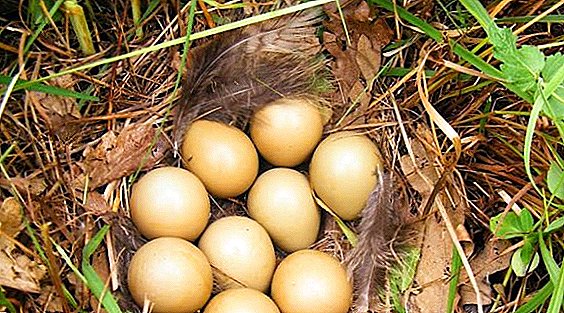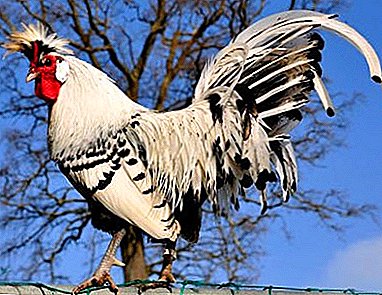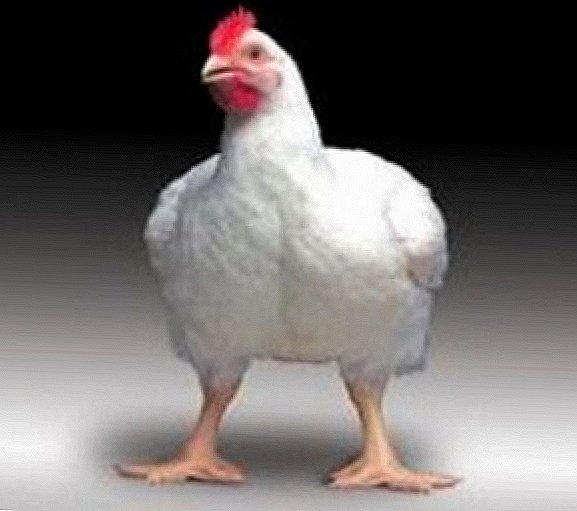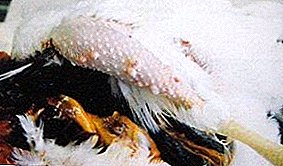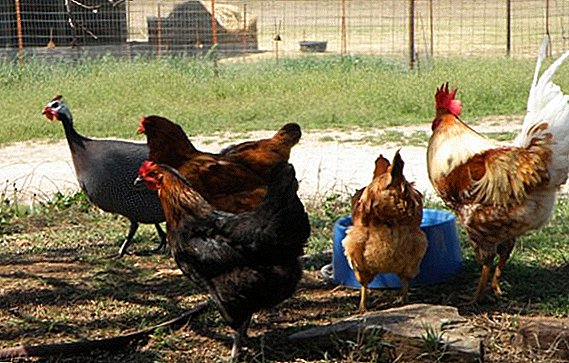 Guinea fowl is an amazing bird that is able to please not only with its high aesthetic data, but also with excellent taste of meat, good egg production. However, many breeders do not risk breeding it, fearing that the bird needs special conditions, special maintenance and food. In fact, this is far from reality: "royal" birds are unpretentious in care, have excellent immunity and good health, and may well exist in the same area with traditional chickens.
Guinea fowl is an amazing bird that is able to please not only with its high aesthetic data, but also with excellent taste of meat, good egg production. However, many breeders do not risk breeding it, fearing that the bird needs special conditions, special maintenance and food. In fact, this is far from reality: "royal" birds are unpretentious in care, have excellent immunity and good health, and may well exist in the same area with traditional chickens.
Can guinea fowl and chickens be kept together
Since guinea fowls belong to the order of chicken-like, they perfectly coexist in one hen house with chickens. Nevertheless, each of the birds has its own characteristics, which must necessarily be taken into account during cohabitation. 
What is the advantage
According to many poultry farmers, keeping chickens and “royal specimens” in the same room is quite simple and beneficial.
Read also about the joint keeping of chickens with quails, ducks, turkeys, rabbits.
Such cohabitation has several key advantages:
- The same diet. If chickens and guinea fowls are grown in order to get good, high-quality meat, then they need an almost identical diet: cereals, wet mash, vegetables, greens, complexes of vitamins and minerals. The same menu will not allow the breeders to spend a lot of time and effort on feeding the birds.
- Similar conditions of detention. The conditions for keeping birds are fairly simple: they sit together on a perch, use the same nests to hatch eggs, need clean, comfortable air temperature in the room, normal humidity. For their cultivation in the coop should provide good lighting and heating, monitor the dryness and cleanliness of the litter.
- Hatching eggs - One of the main advantages of living together "royal birds" and chickens. The fact is that the former do not have a well-developed maternal instinct, therefore, farmers often lay their eggs under the hen hen that copes well with the responsibilities assigned to it.
- With regard to the relationship between species of birds, in general, they get along well with each other. Sometimes the roosters can show aggression towards their "relatives" and enter into conflicts. To minimize this behavior, it is recommended to keep the birds in the same house since childhood.
Important! Before settling the chicken coop with different types of birds, experts recommend to stock up some guinea fowls for chickens and look at the behavior. If serious conflicts do not arise and the birds can exist peacefully, in this case, the number of “royal individuals” can be increased.
disadvantages
Cohabitation of chickens and guinea fowl on the same territory also has its drawbacks. 
- freedom. As is known, the guinea fowl is a very freedom-loving bird, for its comfortable development it is necessary to have space and walking. Birds do not accept the cramped and cage content, need a sufficiently large space, while chickens can live in cages or in small closed poultry houses.
- Breeding. The same applies to the breeding process. Chickens can be fine in the close henhouse for breeding, while guinea fowls need an open-air cage or a paddock.
- Mating capability. Roosters can cover not only female chickens, but also guinea fowls, which will cause the appearance of hybrids - birds, outwardly similar to the "royal specimens", but with the plumage of a chicken.
Did you know? The first hybrid from the female guinea fowl and rooster appeared in the mid-80s of the last century in VNITIPE, in Sergiev Posad. It was noted that the offspring of such hybrid birds was completely fruitless.
Content sharing
If the content of chickens and "royal birds" is supposed to be in the same room, then breeders should know some features of organizing a joint "life". 
Features of the organization of the premises
To ensure a comfortable coexistence of hens and guinea fowls, follow these recommendations:
- The first thing that poultry breeders need to do to maintain a quiet and peaceful atmosphere in a hen house is to “clean up” snooty chickens. If the most aggressive representatives are removed from the flock, the rest of the individuals will no longer behave defiantly and, as a result, they will get on well with their relatives.
- Care must be taken to install in the house a sufficient number of pits on which birds will rest, and nests for hatching eggs. Again, their insufficient number can lead to the fact that the birds begin to conflict with each other.
- In order for chickens and guinea fowls not to crowd, the room where they will be should be as spacious as possible. Placing guinea fowls in the house should be based on 2-3 individuals per 1 square. m floor. Also for the birds you need to create an open-air cage with a large territory for walking. The walking distance is recommended to be fenced with a net height of at least two meters so that the “royal” birds do not fly.
- Chickens and their “brothers” love to swim or rummage in the ground, so you should put special baths with sand or ash for the birds. Access to clean and fresh water is a must for birds. Drinkers and feeders daily need to be cleaned and thoroughly cleaned from dirt.
Did you know? Guinea fowl eggs are a highly nourishing, hypoallergenic product that contains a large amount of protein. Due to the record-keeping period of storage, the quality of such eggs is much higher than chicken eggs. In addition, due to thick shells, they are not susceptible to the development of salmonella or other pathogens.
How to feed guinea fowls and chickens
In the conditions of home cultivation, the ration of guinea fowls and chickens consists of cereals, wet mash beans, fortified supplements, greens, or special combined feeds. As a rule, birds are fed two or three times a day, however, when free-range, it is enough for birds to give food in the evening. In the morning and at lunch it is recommended to feed them with wet mash, in the evening - with grain mixtures.  The main menu of birds includes:
The main menu of birds includes:
- grain mixtures: corn, oats, millet, barley, wheat;
- vegetables: boiled potatoes, carrots, pumpkin, beets;
- greens: grass, clover, tops of plants - in the summer; hay, needles, grass pellets - in winter;
- additives: shells, chalk, fish oil, bone meal, yeast, salt.
With the onset of egg-laying, the ration of birds is enriched with vitamins and minerals, including calcium and phosphorus. In winter, the missing greens are replaced by root crops, hay and pine needles. In summer, birds can graze in a garden or a vegetable garden, pick up various insects, bugs, and spiders.
Important! Despite the fact that protein for the body of birds is extremely necessary, you should carefully monitor portions of food, because an excess of protein can lead to a decrease in immunity and, as a consequence, the development of various diseases.
Rules of walking
If chickens are not critical of the lack of walking, then for guinea fowls - this is a real punishment. They adore freedom and fresh air, therefore walking should be organized necessarily under any climatic conditions. "Tsar's individuals" perfectly tolerate cold and can take walks at temperatures up to -30 degrees.  Territory for walking should be spacious enough, large, fenced. It is good to organize a small indoor shed, where the birds would hide from the sun or rain. Also, the entire area must be carefully cleaned of branches, knots, snow, foliage, so that birds could not get hurt. As a rule, guinea fowls walk separately from chickens, having gathered in one flock.
Territory for walking should be spacious enough, large, fenced. It is good to organize a small indoor shed, where the birds would hide from the sun or rain. Also, the entire area must be carefully cleaned of branches, knots, snow, foliage, so that birds could not get hurt. As a rule, guinea fowls walk separately from chickens, having gathered in one flock.
Learn how chickens of different ages get along.
Hybrid guinea fowl and chicken
Often the coexistence of hens and chickens leads to the appearance of hybrids. In this case, hybridization occurs due to mating of guinea fowl and rooster, while backcrossing is practically reduced to zero.
Crossing chickens and guinea fowls allows you to get viable hybrids, but the young are hatching very little. Such specimens resemble guinea fowls outwardly; on their head they lack a crest and earrings, the body is rather massive and large, with chicken plumage. In a hybrid bird, the sex glands are absent, and even after opening it is almost impossible to determine the sex. But these birds have good health, good immunity and excellent resistance to various ailments.
Video: hybrid of guinea fowl and chicken
Poultry farmers reviews

Despite the fact that guinea fowls and chickens may well exist in the same room, many breeders prefer to keep them separately. Guinea fowl - birds are free and fearful, they do not tolerate life locked up, need a large space and a calm company. However, conflicts between them and bullying chickens are inevitable, and frequent stress and anxiety negatively affect the egg production of birds and the taste of their meat.



